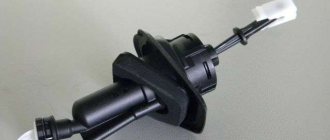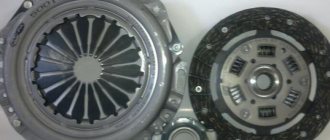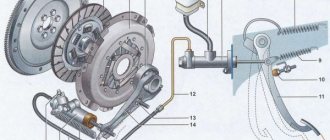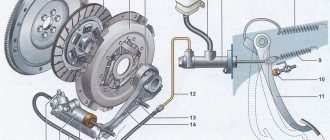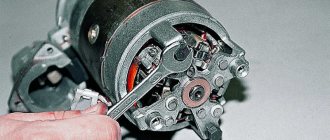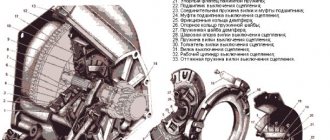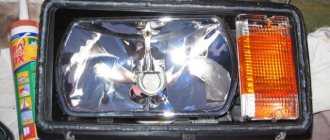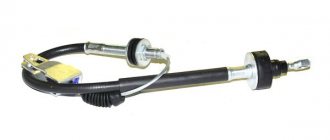Bleeding the clutch of the VAZ 2107, like other cars of the classic family (starting from 2101), is necessary after any operation to repair parts of its drive. It is necessary to bleed the circuit after replacing the master or working cylinder, hose or tube, as well as when changing the fluid. The task of the manipulation is to ensure that there is no air in the clutch hydraulic drive.
How to perform this procedure on a carburetor or injection car and what difficulties there may be - see the instructions.
In what situations should you pump
Any repair of the hydraulic drive that causes its depressurization, as well as changing the working fluid, is a direct indication for pumping. But, even if the parts or fluid have not been changed, the clutch is bled when air enters, disrupting the operation of the hydraulic drive.
Signs that the circuit is airy and the clutch needs bleeding on a VAZ 2107 are:
- pedal travel is too soft;
- difficulties and crunching when shifting gears, up to the impossibility of shifting and/or moving;
- howling or vibration when holding the clutch pedal in gear.
One of the ways to diagnose incomplete disengagement of the Zhiguli clutch is to hang the rear axle (on a lift or jacks), start the engine, engage 3rd or 4th gear and hold the clutch depressed. If the wheels begin to rotate quickly even with the pedal depressed, it means that the engine is not completely disconnected from the transmission. To correct the situation, you need to either adjust the drive or bleed the VAZ 2107 clutch cylinder.
Dismantling the hydraulic drive
To perform the operation we will need:
- container for operating fluid and a large-volume syringe.
- set of wrenches and sockets;
- screwdriver and pliers.
The order of work is as follows:
- Brake fluid is pumped out from the expansion tank of the master cylinder of a VAZ 2107 car using a syringe. A rubber tube is disconnected from the drive, from which the remains are also poured into the prepared container. If liquid gets on paint surfaces, they must be wiped with a damp cloth.
- Using an open-end wrench set to “10”, unscrew the fitting of the pipeline connecting the main and working hydraulic drives.
- Using a “13” socket and an extension adapter, unscrew the nuts holding the assembly to the engine compartment panel.
- To remove the master cylinder from the studs, simply press the clutch pedal, this will move it out of place, after which you can pull it out by hand.
How to bleed the clutch on a VAZ 2107: preparation
Clutch slave cylinder and its bleeder fitting
Before bleeding the clutch on a VAZ 2107, you need to prepare tools and consumables:
- wrench 8;
- dry rags;
- a thin transparent hose (a medical dropper works well);
- container for draining the working fluid;
- liter bottle of fresh brake fluid.
As a key that will be used to open the bleeder fitting, it is better to take a socket, clamping, or deep socket 8, since open-end wrenches lick the edges. The length of the hose should be about 0.5-1 meter. Brake fluid of the VAZ 2107 can be used as a working fluid, grade DOT-4 (more often used on injection cars) or DOT-3 (usually filled in older carburetor models). A container of 0.5 liters is enough, even if a complete replacement is needed, so taking more makes sense only when it is also necessary to bleed the brake system.
Design and principle of operation of the clutch
The clutch pedal is connected to the clutch master cylinder through a rod. The same rod acts as a piston in this cylinder. There is also a working cylinder - it is installed on the clutch housing. The piston of this cylinder is connected to the release fork.
The force from the driver's foot is transmitted through fluid, so the clutch cylinders are connected to each other by a pipeline.
Fluid is supplied to the master cylinder from the reservoir. The working element is ordinary brake fluid.
It all works like this: the driver presses the clutch pedal, the rod enters the master cylinder and pushes the fluid out of it.
To prevent the liquid from flowing back into the tank, the piston closes the supply fitting from the tank.
Since the fluid is not compressed, it moves through the pipeline and begins to press on the piston in the working cylinder. This piston comes out and pushes the fork, which acts on the release bearing.
When the pedal is released, the fork spring pushes the piston back into the slave cylinder and the fluid returns to the master cylinder.
This scheme seems simple, but may not always be reliable. If air gets inside the drive system, the efficiency of the clutch will decrease.
Air bubbles in the system will be compressed when pressure arises, this will lead to the fact that the full force will not be transmitted.
Because of this, even with the pedal fully depressed, the output of the working cylinder rod will be incomplete, the fork will not fully depress the bearing - as a result, the clutch “drives”.
How to bleed the clutch on a VAZ 2107: injector and carburetor
All Zhiguli cars use the same type of hydraulic clutch, so the type of power supply to the VAZ 2107 engine (injector or carburetor) and its model (2101, 2103, 2104, 2105, 2106) do not play a decisive role. The only nuances can be in the features of access to the drive cylinder, since the carburetor allows you to bleed the clutch on a VAZ 2107 a little faster than an injector. Below we will look at detailed instructions on what methods you can pump up and why you may not succeed.
On cars with an injection power system, a larger air filter and a fuel adsorber are used, located on the left side of the engine compartment. They leave less space to access the cylinder from above (no pit), but usually do not require removal for bleeding.
Bleeding the clutch yourself
Like any other job, bleeding the clutch requires a number of preliminary steps. In addition to the tools and equipment, the list of which is listed below, you need to check the level of hydraulic fluid in the tank; it should not be below normal. Then you need to clean the clutch assembly from dirt. This will greatly facilitate the implementation of all subsequent stages. To work you need to prepare:
- brake fluid;
- an empty small container for draining hydraulic fluid and a hose whose diameter must correspond to the drain fitting;
- standard set of tools for a car;
- a stop for fixing the clutch pedal, in the event that you did not have an assistant and had to perform the operations yourself.
Before proceeding with the immediate stages of bleeding on systems with hydraulic and mechanical clutches, you need to configure it. The need for adjustment is determined by the fact that the lack of free play for the main cylinder piston pusher (main cylinder) makes it impossible to carry out the bleeding operation. In fact, the piston and pusher is a shut-off valve.
How to properly bleed the clutch on a VAZ 2107: step-by-step instructions
Bleeding the clutch on a VAZ 2107 should be done in a pit, overpass or lift, but in this case it may be necessary to dismantle the sub-engine protection (if installed). It is also possible to bleed from above by simply placing the machine on a level surface, but this is a little more difficult. The easiest way to pump the clutch of a VAZ 2107 is with an assistant, in which case the order of work will be as follows:
Video instructions on how to bleed the clutch on a classic VAZ in several ways
- Open the hood and remove the cover from the clutch expansion tank, located on the left on the engine shield, you need to add fluid there to the maximum.
- You need to get to the clutch slave cylinder, located to the left of the gearbox bell.
- Remove the rubber cap from the bleeder fitting, put a 8mm wrench on it and put on the hose.
- Pour 100 grams of fresh DOT 3/4 fluid into a container for draining and dip the end of the hose into it (to prevent air leaks).
- Ask an assistant to pump the clutch pedal about 5 times at intervals of 1-3 seconds and leave it depressed.
- Open the fitting of the clutch slave cylinder 0.5-1 turn of the key so that liquid flows through the hose.
- Close the fitting when the liquid stops flowing.
- Check the fuel fluid level in the tank, and if it drops, add more.
- Repeat steps 5-8 until the liquid begins to flow in an even stream without bubbles.
- Tighten the fitting, wipe the parts with a rag to remove any leaks and put the rubber cap back on.
- Check the fluid level in the tank (if it’s low, add it again) and screw on the cap.
By following these simple procedures, you will bleed the clutch drive system on a classic and achieve smooth operation.
Tuned sports clutch
In motor sports, which is a kind of testing ground for the development and implementation of innovations in vehicle components and mechanisms, an increased load is applied to the special clutch. After all, this unit is operated when rotating at an angular speed of 6-10 thousand rpm and at the maximum power values of the power unit.
At the same time, the impact on the drive pedal increases, which creates some problems in the speed of gearbox shifting. Therefore, components such as Kevlar alloy, ceramics or polymer carbon are used as friction linings for the drive type disc. Each type of such friction compounds has its own advantages and disadvantages.
Ceramics does not heat up and withstands large impacts, but it requires the creation of high clamping force and has a reduced friction force. Carbon has high resistance to the mating surface, low material density and high heat resistance. Kevlar alloy has increased wear resistance, heat resistance and at the same time has a reduced friction index.
How to pump the clutch of a VAZ 2107 yourself: alternative methods
If asking someone to pump the pedal is not possible, you need to bleed the VAZ 2107 clutch without an assistant. There is nothing complicated in this procedure either. You can bleed the clutch on a VAZ 2107 yourself in the following ways:
How to bleed the clutch on a classic yourself
- pedal fixation;
- pressure;
- vacuum;
- by gravity.
Bleeding the VAZ 2107 clutch with pedal fixation
Since it is impossible to bleed the clutch pedal of a VAZ 2107 and at the same time work with the fitting yourself, you can try using a gas lift of a suitable length with a force of 100 N instead of an assistant. A board, a piece of pipe or another oblong object that can be used to support the pedal in the depressed position will also do. The further procedure for bleeding the Zhiguli clutch is the same as with an assistant. The only difference is that you will have to pump the pedal and fix it when depressed yourself.
Bleeding the VAZ 2107 clutch under pressure
The second option on how to bleed the clutch of a VAZ 2107 yourself is under pressure. To do this, you need to take a large syringe (preferably 20 cubic meters or more), some kind of container for collecting liquid and perform the following manipulations:
- Draw up a full syringe of TJ.
- Connect the syringe and the fitting with a hose from the dropper.
- Open the hydraulic clutch expansion tank.
- Open the bleeder fitting with a size 8 key and start pumping liquid into the cylinder with a syringe, creating pressure.
- Press fresh fluid into the cylinder until there are no more bubbles in the reservoir.
- Tighten the fitting, wipe everything with a rag, put on the cap and close the tank.
To prevent the tank from flowing over the edge when pumping, you need to either pump out excess liquid in a timely manner (for example, with a second syringe), or provide a container into which they will pour themselves.
Bleeding the VAZ 2107 clutch with vacuum
You can create a vacuum in the system and bleed the clutch slave cylinder using a large medical syringe.
Another way to quickly pump the clutch on a VAZ 2107 alone is to pump it with vacuum (vacuum). It occurs on the same principle as under pressure, but the liquid does not need to be supplied, but rather pumped out. The general procedure for bleeding the clutch cylinders on the seven is as follows:
- Open the reservoir and add liquid up to the neck.
- We put the key on the fitting, put the hose on it, and the other end on the syringe.
- We open the fitting and use a syringe to draw liquid from the cylinder, controlling the level in the tank.
- Periodically add DOT-4, not allowing it to fall below 1.5-2 cm from the bottom of the tank.
- We stop drawing the liquid after it flows into the syringe in a stream without bubbles, and tighten the fitting.
- We remove the device, wipe the cylinder of liquid, put on the cap and close the reservoir lid.
Bleeding the clutch on a VAZ classic by gravity
You can bleed the clutch on a VAZ 2107 with your own hands by gravity, but it will take a little longer. To do this you need:
- Open the tank cap.
- Place the hose onto the fitting, dipping the end into the drain container, and open the fitting.
- Start adding liquid to the tank, watching the stream flow down the hose.
- Stop adding when the stream becomes smooth and free of bubbles.
- Tighten the fitting, remove the hose, wipe away any leaks, put on the cap and close the tank cap.
Hydraulic drive installation
Replacing a mechanism involves purchasing it in a retail network or via the Internet. Installation work is performed in the following sequence:
- The clutch master cylinder of the VAZ 2107 is put on the studs and pushed all the way to the base.
- The nuts are screwed onto the fasteners and tightened with a wrench to “13”.
- The union nut of the pipeline laid to the working hydraulic drive is screwed into the main cylinder.
- The rubber tube is connected to a plastic connecting element and secured with a clamp.
- The expansion tank is filled with brake fluid, which enters the main and slave cylinders of the clutch through tubes. Replacing the fluid in the system is mandatory due to wear products.
Upon completion of installation of parts, it is necessary to inspect and check the tightness of the nuts. Replacing the main or working clutch drive of a VAZ 2107 car ends with bleeding the system.
Tips and tricks
The main advice when carrying out such work should be to use only high-quality brake fluid, since constant malfunctions in the hydraulics of the clutch pedal will entail a whole bunch of problems in the form of failure of other parts. You should also carefully monitor the level of the working substance in the tank and other elements of the system for natural wear and tear. These include, in addition to the main cylinder, various fittings and rubber tubes, which tend to dry out and have microcracks.
When do you need to adjust the clutch on Lada 2107?
It is recommended to check the settings regularly at every car maintenance. But there are still signs when the procedure should be started immediately, so it wouldn’t hurt any owner to know how to bleed the clutch on a VAZ 2107 on their own. Malfunctions in the operation of the coupling during operation are expressed by the following symptoms:
- Slipping – the clutch disc slips when the pedal is fully released, and is unable to transfer all the power from the internal combustion engine to the transmission.
- Drives - the disc does not move away from the flywheel when the pedal is fully depressed, which makes it difficult to change gears.
What should I check?
The clutch may engage too early or late due to the pedal not moving properly, resulting in jerking while driving. The free play of the pedal should be within 0.4-2.0 mm; if these indicators are violated, then adjustments are necessary.
If you look under the car, you can check the free play between the pusher (indicated by the red arrow) and the release fork (blue arrow). Before adjusting the clutch on a VAZ 2107, you need to pump the fork by hand; if there is no free play or exceeds 5 mm, then adjustment of the unit is necessary, because the release bearing will be subject to constant loads.
If all adjustment parameters are normal, the pedal stroke before the clutch starts engaging should be 25-35 mm. This is determined using a ruler; if the indicator does not correspond to the norm, then you will have to adjust some components of the clutch drive system.
